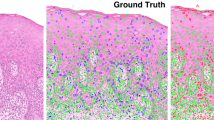Abstract
In a retrospective survey of 235 cases in which the diagnosis on biopsy was lichen planus, keratosis or leukoplakia, the histological features were re-assessed as objectively as possible and without reference to the original diagnosis.
The tissue changes were recorded under 39 headings, and many were assessed on a roughly quantitative basis. In addition, two clinical features were included; whether the biopsy was from the buccal mucosa (as opposed to some other intraoral site) and whether the lesions involved multiple intraoral sites. For each possible pair of diagnostic categories (keratosis and leukoplakia, lichen planus and keratosis, lichen planus and leukoplakia) the recorded findings were subjected to discriminant analysis in order to provide a quantitative assessment of the value of each individual feature for discriminating between the two diagnostic groups. The computer programme also provided for the application of these calculated values to yield a “score” for each case, and for an assessment of the significance of the separation of the diagnostic groups thus achieved. In general, the values calculated by the computer for the discriminatory value of each tissue change accorded with our subjective impressions, but a number of features that were given a relatively high value had not previously been recognized as important in differential diagnosis
A discriminant analysis was also performed on those cases of leukoplakia known to have later developed a carcinoma, in comparison with the leukoplakia cases that did not develop carcinoma. High values were accorded mainly to the well-known features of epithelial atypia, but a similar high value was indicated for the presence of Russell bodies. we had not previously realized that the presence of Russell bodies was of prognostic significance in this context.
When the total scores for the groups of cases were analysed, it was found that the separation of each pair of diagnostic groups was significant at the 1% level. The separation of leukoplakia cases that subsequently developed carcinoma, from those that did not develop carcinoma, was significant at the 5% level. In this latter analysis, a better separation might be achieved with larger numbers of cases, but there will always be the complicating factor that an unknown number of leukoplakia cases would develop carcinoma if the patient had received no treatment.
This is a preview of subscription content, access via your institution
Access options
Subscribe to this journal
Receive 24 print issues and online access
$259.00 per year
only $10.79 per issue
Buy this article
- Purchase on Springer Link
- Instant access to full article PDF
Prices may be subject to local taxes which are calculated during checkout
Similar content being viewed by others

Rights and permissions
About this article
Cite this article
Kramer, I., Lucas, R., El-Labban, N. et al. The Use of Discriminant Analysis for Examining the Histological Features of Oral Keratoses and Lichen Planus. Br J Cancer 24, 673–683 (1970). https://doi.org/10.1038/bjc.1970.80
Issue Date:
DOI: https://doi.org/10.1038/bjc.1970.80
This article is cited by
-
Prediction of malignant transformation and recurrence of oral epithelial dysplasia using architectural and cytological feature specific prognostic models
Modern Pathology (2022)
-
Upregulation of epidermal growth factor receptor 4 in oral leukoplakia
International Journal of Oral Science (2013)


